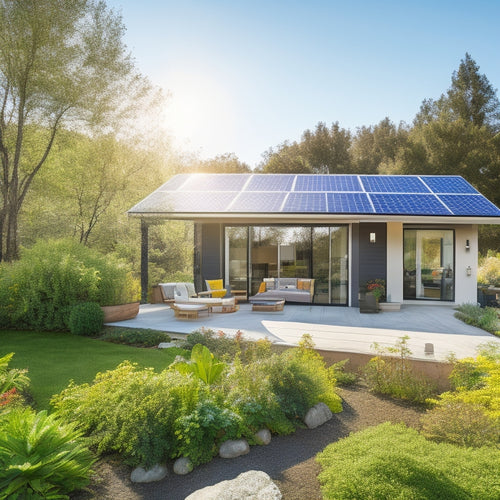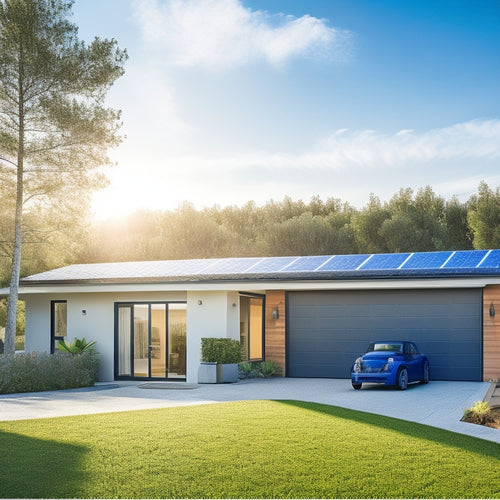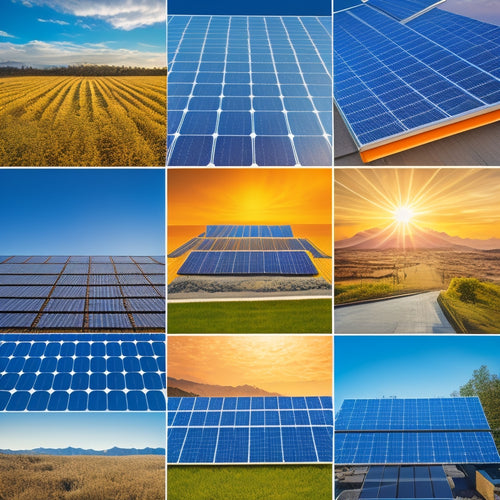
Installing a Solar Panel System for Your Business
Share
You're considering installing a solar panel system for your business, a smart move to reduce energy costs and boost your bottom line. To get started, assess your energy needs by calculating daily consumption, tracking usage patterns, and identifying areas of waste. Choose the right system size, evaluate roof space and condition, and select high-efficiency solar panels. Familiarize yourself with local building codes, obtain necessary permits, and prepare your facility for installation. With proper planning, you'll be generating clean energy and saving money in no time. Now, take the next step to harness the power of solar energy.
Key Takeaways
• Assess your business's energy needs by tracking usage patterns and auditing energy waste to determine the right system size for your solar panel installation.
• Choose high-efficiency and durable solar panels that meet certifications like UL or IEC, and evaluate photovoltaic cell types for optimal performance.
• Ensure compliance with local building codes and regulations, obtaining necessary permits and approvals before installation to avoid costly rework.
• Prepare your site by clearing the area, confirming timelines, and preparing staff and facilities to minimize disruptions during installation.
• Monitor your system's performance regularly to optimize energy production, detect potential issues, and schedule maintenance to ensure long-term efficiency.
Assessing Your Energy Needs
To determine the size of the solar panel system you need, start by calculating your total daily energy consumption in watt-hours (Wh) by tracking your energy usage over a week or a month. This will give you a clear picture of your energy needs and help you identify areas for improvement.
Conducting an energy examination is an important step in this process, as it helps you identify energy-intensive areas and opportunities for energy efficiency upgrades. By analyzing your energy usage patterns, you can pinpoint areas where energy is being wasted and take corrective measures to optimize energy efficiency.
During the energy examination, you'll gather data on your energy consumption, including the type and quantity of appliances, lighting, and HVAC systems. This information will help you identify opportunities to reduce energy waste and improve energy efficiency.
By implementing energy-efficient measures, you can reduce your energy consumption, which in turn will reduce the size of the solar panel system you need. This won't only save you money on your energy bills but also reduce your carbon footprint.
Choosing the Right System Size
Now that you've assessed your energy needs, it's time to choose the right system size for your solar panel installation.
To do this, you'll need to determine the quantity of panels required and calculate the system's capacity to make sure it meets your energy demands.
Assessing Energy Needs
By examining your past year's energy bills, you can accurately determine your average daily energy consumption, which is essential in choosing the right system size for your solar panel installation. This evaluation will help you identify areas of energy inefficiency, allowing you to make targeted improvements and maximize your cost savings.
Conducting an energy audit will provide a thorough understanding of your energy usage patterns, revealing opportunities to optimize your energy consumption and reduce your reliance on the grid.
When analyzing your energy needs, consider factors such as your business's operating hours, equipment usage, and lighting requirements. This information will enable you to determine the ideal system size that meets your energy demands. A properly sized system will ensure you reap the maximum benefits of solar energy, including significant cost savings and a reduced carbon footprint.
Determining Panel Quantity
With your energy needs assessment in hand, you're ready to determine the ideal number of solar panels required to meet your energy demands. This step is important in ensuring your system is properly sized to meet your business's energy requirements.
To determine the right system size, you'll need to take into account several factors, including your energy usage patterns, available roof space, and local building codes.
Panel efficiency plays a significant role in system sizing. Higher-efficiency panels require less space to produce the same amount of energy, making them ideal for businesses with limited roof space. However, they often come at a higher cost. You'll need to weigh the benefits of higher-efficiency panels against the added expense.
When choosing the right system size, it's crucial to consider the load calculation, which takes into account the total energy requirements of your business. This calculation will help you determine the minimum number of panels required to meet your energy demands.
Calculating System Capacity
How much power will your solar panel system need to generate to meet your business's energy demands, and what's the most efficient system capacity to achieve that? Calculating system capacity is a critical step in designing a top-performing solar panel system.
To determine the right system size, you'll need to assess your business's energy usage patterns, including peak demand periods and overall energy consumption. This information will help you identify the minimum system capacity required to meet your energy needs.
When calculating system capacity, consider factors such as roof size, local building codes, and available mounting space. It's crucial to strike a balance between system size and energy efficiency.
Oversizing your system can lead to increased upfront costs, while undersizing may result in inadequate energy production. A properly sized system will maximize energy efficiency, reduce energy waste, and provide the best return on investment.
Evaluating Roof Space and Condition
You'll need to assess your roof's size, shape, and condition to determine whether it can accommodate a solar panel system. This evaluation is important in ensuring a successful installation.
Start by examining your roof's age, as older roofs may require additional repairs or even replacement before installing solar panels. A roof's structural integrity is also vital, as it must be able to support the weight of the solar panels and withstand various environmental conditions.
Inspect your roof for signs of wear, such as cracks, damaged tiles, or rusty flashing, and address any issues before proceeding. Additionally, consider the roof's orientation, slope, and obstacles like skylights, vents, or chimneys that may affect solar panel placement.
Selecting the Best Solar Panels
Now that you've assessed your roof's suitability for solar panels, it's time to focus on selecting the right solar panels for your system. When choosing solar panels, two critical factors to take into account are Solar Panel Efficiency and Panel Durability.
Solar Panel Efficiency refers to the percentage of sunlight that's converted into electrical energy. Look for panels with high efficiency ratings, typically above 20%, to maximize energy production.
Panel Durability is equally important, as it affects the lifespan of your system. Durable panels can withstand harsh weather conditions and last up to 30 years or more.
When evaluating solar panels, consider the type of photovoltaic cells used. Monocrystalline silicon cells are highly efficient, but more expensive. Polycrystalline silicon cells offer a balance between efficiency and cost. Thin-film cells are less efficient but more affordable.
Additionally, check the panel's certifications, such as UL (Underwriters Laboratories) or IEC (International Electrotechnical Commission), to confirm compliance with industry standards. By taking these factors into account, you'll be able to select the best solar panels for your business, ensuring a reliable and efficient energy system.
Understanding Local Building Codes
Before installing a solar panel system, it's important to familiarize yourself with local building codes and regulations that govern solar installations in your area. You'll need to make sure code compliance, which involves meeting the minimum requirements set by local authorities for solar panel installations. Failing to comply with these regulations can result in costly rework, fines, or even system shutdown.
You'll need to research and understand the zoning regulations in your area, which dictate the types of solar installations allowed, their size, and placement. Some areas may have specific restrictions on the installation of solar panels, such as setbacks from property lines or height limitations.
As you navigate the complex web of local building codes and regulations, keep in mind that they can vary significantly depending on your location. It's important to consult with local authorities, solar panel manufacturers, and installers to make sure you're meeting all the necessary requirements.
Obtaining Necessary Permits
With local building codes and regulations understood, it's crucial to secure the necessary permits to guarantee your solar panel system meets all legal requirements. You'll need to obtain permits from your local government to make sure compliance with government regulations. This involves submitting your system design and installation plans for approval. Be prepared to provide detailed specifications, including the type and number of solar panels, inverters, and mounting hardware. You'll also need to show compliance with electrical and fire safety codes.
Permit fees will vary depending on your location and the complexity of your system. Expect to pay anywhere from a few hundred to several thousand dollars, depending on the jurisdiction and the scope of your project. It's vital to factor these costs into your overall budget to avoid unexpected expenses.
Remember to also plan for potential delays in the permitting process, which can add weeks or even months to your project timeline. By understanding the permitting process and associated fees, you can navigate government regulations with confidence and ensure a successful solar panel installation.
Preparing for Installation Day
Preparing for Installation Day
To guarantee a seamless installation process, you'll want to prepare your site by clearing the area around your roof or installation zone of any debris, obstructions, or hazardous materials. This site cleanup is essential to make certain the installation team can work efficiently and safely. Remove any trash, equipment, or materials that could hinder the installation process or pose a risk to the team.
Next, confirm your installation timeline with the installation team. This will help you plan for any necessary shutdowns or disruptions to your business operations. Be sure to ask about the expected duration of the installation, the number of personnel involved, and their equipment requirements. This will help you prepare your staff and facilities for the installation process.
Installing the Solar Panel System
As you begin installing your solar panel system, you'll need to conduct a thorough site assessment to guarantee a safe and efficient installation.
Your installation team will prepare the site by clearing the area, removing any debris, and setting up necessary equipment.
With a solid plan in place, you'll be ready to start installing the solar panels and other system components.
Site Assessment Required
You need to conduct a comprehensive site assessment to determine whether your location is suitable for a solar panel system, considering factors such as shading, roof size, and local building codes. This assessment is vital in identifying potential obstacles that could impact the system's performance.
A site assessment involves evaluating your location's site history, including any previous construction or renovation projects that may have affected the building's structural integrity. Environmental factors, such as nearby trees or buildings that could cast shade, must also be taken into account.
Additionally, you'll need to review local building codes and ordinances to guarantee compliance. A thorough site assessment will help you identify potential issues and determine the best system design for your business.
Installation Team Prepares
With your site assessment complete, your installation team is now ready to begin preparing the installation site, ensuring a safe and efficient setup for the solar panel system. As the team leader, you'll oversee the entire process, ensuring that each team member understands their role and responsibilities. Strong team dynamics are vital at this stage, as effective communication and collaboration will guarantee a seamless installation process.
Before commencing the installation, your team will conduct thorough safety briefings to identify potential hazards and develop strategies to mitigate them. This includes reviewing the site's unique challenges, such as rooftop obstacles or electrical infrastructure limitations. Your team will also review the installation plan, confirming that all necessary equipment and materials are on-site and ready for use.
During the preparation phase, your team will also establish a clear workflow, designating specific tasks and timelines to ensure the installation stays on schedule. By prioritizing safety and efficiency, you'll set your team up for success, minimizing the risk of delays or accidents and ensuring a successful solar panel system installation.
Connecting to the Grid
Grid connection involves synchronizing your solar panel system's electrical output with the utility grid's frequency and voltage requirements, ensuring a safe and efficient transfer of excess energy back to the grid. This connection enables you to sell excess energy back to the grid, a process known as 'net metering.'
As you reach grid parity, where the cost of generating electricity from your solar panels equals or is less than the cost of buying from the grid, you can offset your energy consumption and reduce your utility bills.
To facilitate this process, you'll need to install a bi-directional utility meter. This advanced meter measures the flow of energy in both directions, tracking how much electricity you're producing and feeding back into the grid. Your utility company will provide this meter, and it will be installed alongside your existing meter.
With net metering, you can generate revenue by selling excess energy back to the grid, further increasing the return on your investment in solar energy. By connecting to the grid, you're not only reducing your energy costs but also contributing to a more sustainable energy future.
Monitoring and Maintaining Performance
As you install your solar panel system, it's important to monitor its performance to make sure you're maximizing energy output.
You'll want to track your energy production regularly to identify any potential issues or areas for improvement.
Energy Output Tracking
You'll need to track your solar panel system's energy output to guarantee it's performing at its best, and this involves monitoring its daily, weekly, and monthly production. This is where energy output tracking comes in – a critical aspect of maintaining your system's peak performance. By analyzing your system's energy output, you'll be able to identify potential issues, optimize its performance, and maximize your return on investment.
| Performance Metrics | Data Analytics | Optimization Strategy |
|---|---|---|
| Daily Energy Output (kWh) | Historical data comparison | Adjust panel angles for maximum energy harvest |
| Weekly Energy Output (kWh) | Seasonal performance analysis | Clean panels to maintain efficiency |
| Monthly Energy Output (kWh) | Energy consumption forecasting | Adjust inverter settings for peak performance |
| System Efficiency (%) | Real-time monitoring | Identify and replace underperforming panels |
| Carbon Emissions Reduction (tons) | Comparative analysis with industry benchmarks | Optimize system configuration for maximum impact |
Regular System Inspection
To guarantee your solar panel system operates at peak performance, routine inspections are crucial for identifying and addressing potential issues before they escalate into major problems. By performing regular system checks, you'll be able to detect and correct minor issues before they become major headaches. This proactive approach will help you avoid costly repairs, reduce downtime, and ensure your system is generating maximum energy output.
To maintain top performance, it's important to establish a maintenance schedule tailored to your specific system. This schedule should include regular inspections of the entire system, including the panels, inverters, and mounting structures.
During these inspections, you should check for signs of wear and tear, corrosion, and damage. Additionally, you should verify that all electrical connections are secure, and that the system is properly grounded.
Frequently Asked Questions
Can I Install Solar Panels on a Flat Roof?
While you might worry that a flat roof won't support solar panels, you'll be relieved to know that with proper assessment, you can overcome roof size limitations and structural integrity concerns, ensuring a safe and efficient installation.
Are Solar Panels Affected by Shade From Trees?
When you're evaluating your solar panel setup, keep in mind that trees can greatly impact energy production; a single tree canopy can cast shade, reducing output, so consider shade mitigation strategies to optimize performance.
How Long Does a Solar Panel System Last?
You can rest assured that a well-maintained solar panel system can last up to 30 years or more, with some panels still producing 80% of their original power after 25 years, thanks to exceptional panel durability and system longevity.
Will Solar Panels Increase My Property Value?
You'll reap a significant appraisal boost, as solar panels increase your property value, giving you a resale advantage, with studies showing a 3-5% increase in resale value, making your investment a smart business move.
Can I Install Solar Panels Myself?
"You shouldn't attempt to install solar panels yourself, as it requires meeting specific electrician requirements and ensuring DIY safety protocols to avoid electrical shock, fire hazards, and system inefficiencies."
Related Posts
-

Green Home Improvements Using Solar Power
Investing in solar power alters your home into a sustainable haven while slashing energy costs. You can greatly reduc...
-

Solar Energy Storage Options for Homes
When considering solar energy storage options for your home, you'll find several effective solutions. Battery systems...
-

Comparative Analysis of Top Solar Brands
To conduct a comparative analysis of top solar brands, focus on key metrics like durability, energy efficiency, and s...


